Aha! Moments: The Instant of Creative Insight

Did you ever wake up in the morning and realize suddenly that you've solved a problem, one that had been occupying your mind for some time? Or, have you ever been daydreaming, perhaps while working at a task that required little attention, and then suddenly had a Eureka! moment, an instant of sudden insight? If so, then you can relate to the experience of the personalities described below. Each of these had a very famous, and historic, Eureka! moment.



Einstein
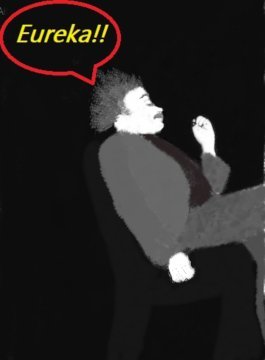

Where did the inspiration come from for Einstein's General Theory of
Relativity? As he explained it, the inspiration for the theory came in a
moment when he wasn't working on it. He was employed at a patent
office and was daydreaming one day. Suddenly the thought came to him:
“If a man falls freely he would not feel his weight.”
(From: The University of Toronto Magazine)
This was Einstein's Eureka! moment. It took much more work to sort out the details, but the principle, the inspiration for his theory came when his mind was not working on the puzzle.
Newton
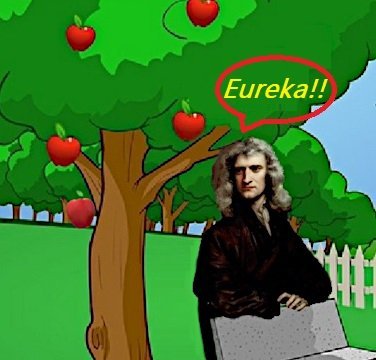

In a book written by William Stukeley, Memoirs of Sir Isaac Newton’s Life (1752), Newton's Eureka! moment is described:
After dinner...we went into the garden and drank thea...he(Newton) told me, he was just in the same situation... when... the notion of gravitation came into his mind. It was occasion’d by the fall of an apple, as he sat in contemplative mood.
Why should that apple always descend perpendicularly to the ground, thought he to himself
(From: The Newton Project )
Kekulé
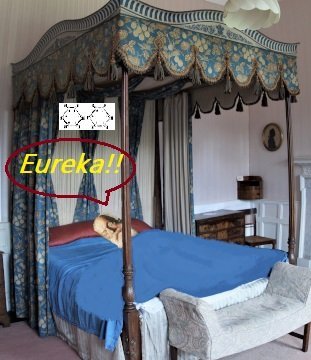

And...Friedrich August Kekulé (1829-1896), one of the most important organic chemists of the nineteenth century, worked out the structure of the benzene molecule in a dream. He explained:
I turned the chair to the fireplace and fell half asleep... the
atoms gamboled before my eyes...My mind’s eyes, trained by visions of a
similar kind, now distinguished larger formations of various shapes...As
if struck by lightning I awoke. This time again I spent the rest of the
night working out the consequences.
(From: Famous Scientists: The Art of Genius)

Each one of these scientists had what has been called an "Aha!" (Eureka!) moment, which is an uncharacteristically simple way neurologists have of describing instances of sudden insight---unscripted, unplanned breakthroughs in understanding.
McCartney
These breakthroughs are not limited to science. Paul McCartney explained how the song Let It Be came to him.
He had a dream about his mother, Mary, who had died ten years before. His mother appeared to him and sought to ease his troubled mind. "Let It Be", she said, in the dream. "Let it Be".
When he woke the next morning, McCartney remembered his mother's
words and realized he had the makings of a song. He sat down at his
piano and proceeded to compose one of the Beatles' most beloved songs:
Let It Be.
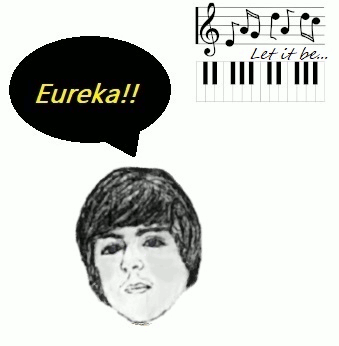


One thing each of these Aha! moments had in common was that inspiration came not in the midst of conscious effort, but while the mind was at rest, or distracted. The nature of these experiences is consistent with a theory of creativity that is currently evolving among some researchers. While there is no unanimity of opinion, there is a growing agreement that creative insight results when different parts of the brain collaborate. However, it seems that the final stage, the Aha! moment, may be the province of the inferior parietal lobe and the anterior temporal gyrus--not the frontal lobe, which is where conscious analysis takes place.
Inferior Parietal Lobe and Anterior Temporal Gyrus at the Moment of Insight
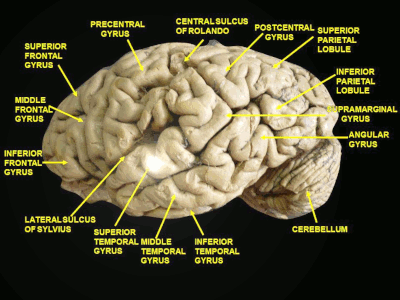
GIF constructed from the following image: Slide2HAN (Brain Slide) by Anatomist 90 on Wikimedia Commons CC 3.0 Unported license
Researchers are interested in understanding the neurological pathways activated during these intense, highly productive moments.
In his book, The Ages of Insight, Nobel-Prize-winning neurologist Eric Kandell states, "There are intriguing, but by no means compelling, suggestions that creativity involves...particularly the right anterior superior temporal gyrus and the right parietal cortex. " (P. 473) Kandell explains that heightened activity is detected in these areas several seconds prior to the moment of insight. He explains that this finding is supported by studies of mathematically gifted children who evince heightened activity in the right parietal lobe and both sides of the frontal cortex during problem solving.
Loss of Inhibition and Creative Expression
Vincent Van Gogh: Early Paintings, and Later Paintings

- Kauernder Junge mit Sichel
- Still Life with Cabbage and Clogs
- An Old Man Putting Dry Rice on the Hearth
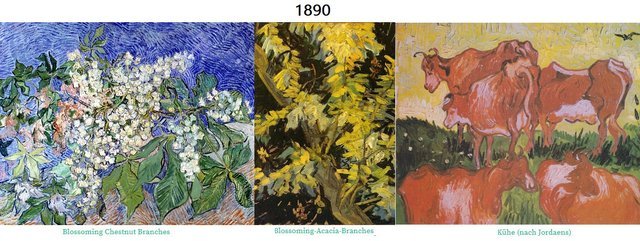
Kendall, and other researchers, suggest that a kind of tension exists between the frontal cortex, where planning and executive function occur, and areas of the brain where creativity flourishes. They posit that when the frontal lobe is working it inhibits other parts of the brain. When the frontal lobe is relaxed (or injured) these areas, where creative expression arises, are freed.
Van Gogh, 1889, Near the End of His Life


While we don't have MRI images of Van Gogh's brain, we do have contemporaneous accounts of his cognitive decline--an inability to care for himself. Over the same period, as his mental state deteriorated, his art became less inhibited. In his last years, repeated bouts of mental illness ..."did not defeat his creative spirit, but spurred it on."
This freeing up of artistic expression in the presence of pathology has been noted in other individuals who suffered injury to the frontal lobe, and afterwards found new, or intensified, abilities in art.
Kendall describes the research of Bruce Miller, a neurologist at UC San Francisco, who worked with a patient suffering from frontal lobe dementia, Jancy Chang.. Chang was an art teacher who had to stop working because of the dementia. As her cognitive ability declined, her artistic expression blossomed.
Miller was so struck by this phenomenon of artistic expression blossoming in (an admitted minority of) dementia patients that he "...began to think of the left side of healthy brains as a bully, suppressing the creative instincts of the other side."
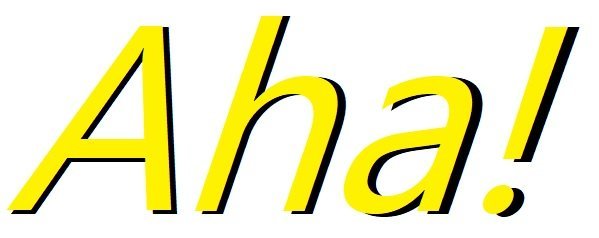
A more nuanced perspective on the tension between executive function and creativity is offered by a pair of researchers from Northwestern and Drexel Universities, Mark Jung-Beeman and John Kounios. Kendall reports that these researchers believe creative insight is the result of different parts of the brain operating at different times. Their studies reveal that the process 'begins in the anterior cingulate regions of the prefrontal cortex and the temporal cortex on both sides of the brain." However, they suggest, the Aha! moment, occurs when intense focus is relaxed.
Anterior Cingulate Cortex is Activated First
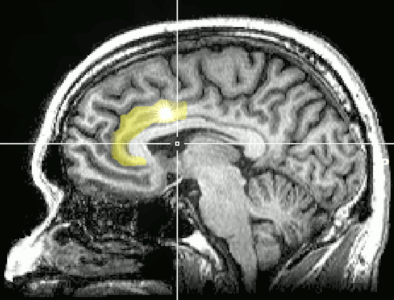

Willem de Kooning
Seated Woman, de Kooning Scupture, 1969
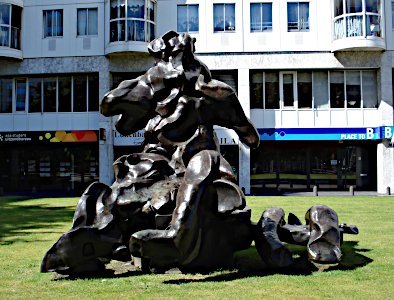

One of the most influential artists of the twentieth century, Willem de Kooning (1904-1997), began to suffer signs of dementia in the 1980s. And yet he continued to paint. The character of the work he produced, however, changed---according to art critics. A 1997 Kooning exhibit at MOMA was described in museum literature with these words: "Presented together for the first time, (these pieces) are the crowning achievement of one of the greatest modern painters."
In 1995 the work was exhibited at the San Francisco MOMA. An article in SFGate carried this assessment by the museum's curator: "When I first saw them (the pieces) in 1984, at a time when nobody knew de Kooning had Alzheimer's, they were glorious, incredible" and "I think the 1980s will turn out to be one of the great periods of de Kooning's art."


Eric Kandell summarizes the implications of, and trends in, research on creativity. Kendall explains that the brain "lavishes a lot of attention" on creativity. It marshals resources from different areas of the brain, exploiting the strengths of each. Left and right hemispheres work "cooperatively and simultaneously" on problem solving. However, the right hemisphere contributes "importantly to creativity". He acknowledges that that we still have limited understanding of the different factors that enable creativity--particularly those factors involved in the "unconscious work that leads to an Aha! moment." (p.484)
It may be reckless to apply developing research to the evolution of de Kooning's and van Gogh's art. But it is fair to speculate. There are intriguing similarities between de Kooning's/van Gogh's evolving art and the artistic blossoming of individuals who have suffered frontal lobe damage. This field of research is still wide open.
The exact seat of creativity and Aha! moments has yet to be determined. But we have persuasive clues. Looking at de Kooning, van Gogh, Einstein, McCartney and Kekulé may help us to understand these clues in everyday terms. As findings become more definitive, this is how research on creativity will be relevant to all of us...every day, as we live our lives.

Acknowledgments: @chappertron suggested Eric Kandell as an outstanding source on the neurological basis of creativity. I ordered The Age of Insight after that recommendation. So glad I did.
Also, @abigail-dantes, who writes on psychology and helps us to understand the physical roots of some behaviors. It was in one of her blogs that I first learned about the existence of the anterior cingulate cortex.
And SteemSTEM, where I met these, and other wonderful people.
Pictures:
Eureka! Public Domain Pictures From Which I Created My Illustrations 😎
Einstein
Newton
Kekulé
Four Poster
Apple Orchard
McCartney Sketch
Piano Notes
Van Gogh Early Pictures (Public domain):
Kauernder Junge mit Sichel.jpeg
Still Life with Cabbage and Clogs.jpg
An Old Man Putting Dry Rice on the Hearth 1881 Vincent van Gogh.jpg/wiki/File
Van Gogh Later Pictures (Public Domain):
Blossoming Chestnut Branches.jpg
Van Gogh Blossoming-Acacia-Branches-1890.jpeg
Van Gogh - Kühe (nach Jordaens).jpeg
Self Portrait
Three Small Accent Pictures (GIF): Van Gogh (Public Domain)
Starry Night Over the Rhone, Vincent van Gogh
The Olive Trees, Vincent van Gogh
Starry Night, Vincent van Gogh
Rose gif, Pixabay
Starry Border: Pixabay
Selected Research Sources
- SFGATE APEX OR DECLINE? / The great painter Willem de Kooning
- University of Toronto Magazine Eureka Moments in History
- NewScientist, Newton's Apple: The Real Story
- Famous Scientists: Friedrich August Kekulé
- The Salt Lake Tribune,Paul McCartney says "Let It Be" came to him in a dream
- The Met: Vincent van Gogh (1853–1890): The Drawings
- Revised Memoir of Newton, By William Stukeley
- The Newton Project)
MOMA William de Kooning: The Late Paintings 1980s - Creative Brain Lab
- Brainworld, The Aha! Moment: The Science Behind Creative Insight
- Famous Scientists: The Art of Genius
- LiveJournal
- Wolf Humanities Center: Portraits of Artists: Creativity in Dementia
- The Creativity Post: The Aha! Moment: the Neural Basis of Solving Problems with Insight
- Encyclopedia.com Kekulé, Friedrich August
- New York Times: Art, The Sculpture of Willem de Kooning
And Most of All: - The Age of Insight: The Quest to Understand the Unconscious in Art, Mind, and Brain, From Vienna 1900 to the Present
by Eric Kandell
Random House, New York
2012
Congratulations @agmoore2! You have completed the following achievement on the Steem blockchain and have been rewarded with new badge(s) :
You can view your badges on your Steem Board and compare to others on the Steem Ranking
If you no longer want to receive notifications, reply to this comment with the word
STOPTo support your work, I also upvoted your post!
Vote for @Steemitboard as a witness to get one more award and increased upvotes!
Thank you, @steemitboard!
You're welcome @agmoore2
Feel free to support us back, vote for our witness.
You will get one more badge and more powerful upvotes from us on your posts with our next notifications.
I had this happen often while I was studying math. I would wake up in the morning with the answer. One time, the answer I "dreamed" was so simple I was ashamed that it had taken me a week to find. I sheepishly turned in my one paragraph proof, and didn't tell anyone how hard it had been for me to complete. The next day I learned that of those who had managed to finish the proof at all, the next shortest proof was three pages! I was able to dream the concept in the simplest of terms, but couldn't find my way through it during conscious thought. I find the correlation between creativity and mathematical thought very interesting. Creativity and abstractness are somehow related.
My first comment!
I can relate. Sometimes, when I'm working on something, I'll deliberately review it before I go to sleep. Then let my mind do its thing. Passive work :) Usually, I wake up with a good idea.
Thank you so much for commenting.
It's a great post. Our tendency is to try to pin this or that on one part of the brain, but the truth is far more complex. What I've learned from your post is that the all the parts of the brain (and I would not be surprised to learn that other parts of the body as well), work together and support each other to make a whole. I find it comforting.
Thank you!
Hello agmoore2!
Congratulations! This post has been randomly Resteemed! For a chance to get more of your content resteemed join the Steem Engine Team
Hey @owasco :D
In this case you will not be surprised to find out that stimuli picked up by sensory nerves in the tongue can be translated into visual information by the brain, and consequently allow blind people to perceive visual inputs Ref. .
Pretty neat, right? :)
That is most definitely neat! And also comforting.
I was thinking along the lines of the hormonal system. I'm sure the adrenals (for instance) kick in or out when a certain type of thought is called for.
I think this could explain why our medical industry is failing us. It focuses too heavily on the part of the body that exhibits a symptom, and ignores all else.
So
taste the rainbowis not exactly a advertising jargon? I'm okay with that.Ha! Good one.
Or .... just a fantastic synesthesia experience 😉
So that's your secret! :D I seee....
😊
No Eureka moments so far 😓. My gyri are not lighting up like Christmas trees I guess, I think and realize very slow.
But as a brain science newbie, I realize that your article is great and needs a resteem :)
Oh, I think those gyri get a regular workout in your head 💥 I read your stuff--so many sparks flying I can't keep up :)
I really appreciate your kind words, and of course, the resteem. These blogs take a lot of time...I love writing them. The best return is when someone I respect says I've done a good job. Thanks very much.
Sometimes, I personally solve tough issues at the bathroom… Or at least I find good tracks to potentially follow to solve my concerns. I would not call that ‘Eureka moments’ in the sense I am no one compared with all the names you mentioned…
To finalise this short comment, I would like to quote something i am telling to all my students. It is important to move away from work once in a while, to clean our mind and be able to re-tackled the problem from other angles. Usually, bottlenecks are solved during those out-of-work moments.
You are always modest. I can imagine the electrical storm that must be in your head sometimes--probably like the night sky lit up with stars :)
Relaxing, disengaging from mundane tasks...something I'm good at (ask my husband). I find that illustrating helps. Doesn't matter if the picture is good. I can throw it away. But it's a pleasant way to turn off analysis. Plus, it's fun.
Thanks for your comment... I love the comments :)
Ask my wife! She can detect those moments where my body is physically present but my mind is lightyears away, working out the equations :D
We all do. With #newsteem, I have the impression more people read and ask questions. By the way, I just got my neutrino picture... Therefore, neutrinos will invade SteemSTEM on Monday or Tuesday next week (I do not think I will manage to write this post before) :)
I'm looking forward to it. I see Abigail has a new post. Have put that off as a treat for later. There is much happening on SteemSTEM. Wonderful to be a part of it :)
This week was so active compared with the previous ones. This is a very welcome change. I hope it will stay like that!
This is a little AH! moment itself! I have had some really vivid ideas during crippling migraines, I never really understood how in a state where I might struggle with basic motor functions or even be able to speak in coherent sentences, I could think of lines/ideas that stuck with me for years, but in that sense it is probably similar to the disengagement/detachment of something like dementia. Gosh it's fascinating how the mind works.
It is also really interesting in terms of taichi, it requires a relaxed focus on a lot of things at once, and is supposed to help balance the different parts of the brain, there is an element of following verbal instructions, moving as part of a group, coordinating breathing with the steps, with themselves coordinate different parts of the body, and following steps from memory. I have a lot of AH! and reflection moments during the class, and have wondered why it works so much better during the class than if i do a few moves at home, but that would make sense!
That is very interesting about the tai chi. If different parts of the body and brain work together, what happens when a group of bodies and brains work together?
Hi Calluna, Nice to see you here, but terrible to learn about your headaches. Some very interesting and talented people have reported experiences similar to yours: here's an article that describes the aura surrounding both migraines and epileptic seizures--in Dostoyevsky, Picasso and Chopin (boy, you're in good company!)
I think the taichi experience makes a lot of sense. You're surrendering, in a sense, your focused driven self. Sounds tempting :)
Thanks again for stopping by. Always good to hear how a creative experiences thought and inspiration.
I like the way you think and express your ideas.
This post has been voted on by the SteemSTEM curation team and voting trail. It is elligible for support from @curie and @minnowbooster.
If you appreciate the work we are doing, then consider supporting our witness @stem.witness. Additional witness support to the curie witness would be appreciated as well.
For additional information please join us on the SteemSTEM discord and to get to know the rest of the community!
Thanks for having used the steemstem.io app and included @steemstem in the list of beneficiaries of this post. This granted you a stronger support from SteemSTEM.
Thank you, SteemSTEM!
Hello my dear friend :)
It's so nice to read this beautifully illustrated and researched work today! Miller's reflection of the left side of the brain being a bit of a bully made me giggle. How nicely put 😄 Not long ago when going through research on language recovery the opposite came up about stroke patients' rehabilitation. That the right hemisphere might "bully" the left, consequently interfering with language recovery Ref. (this remains unclear!).
I am more inclined to follow Beeman and Kounios's line of thought. I think that creative insight is more of a "collaborative work" of different brain areas. As for that aha! moment ... I do have my tiny little ones once in a blue moon. And very much like Breeman and Kounious put it, it happens when I am on a walk or, relaxing in the garden, or even immediately after waking up!
Thank you for the mention my dear @agmoore :) also, I loved what you did with those brain images 😍
Much love from warm Portugal, always & forever :*
...Torture waiting for my VP to replenish so I can upvote at least minimally.
Thank you my dear friend, for your appreciation. You know you were in my mind with this one (besides the overt credit I offered). I'm glad you liked my rather silly illustrations--they were fun and I chuckled as I made them.
This blog was prompted by some of your blogs, by @chappertron's suggestion, and by curiosity about my own thought processes. I agree with you about Beeman and Kounios, and I think Kandell does, also. The reference you provided was interesting, and of course led me to related research, which I will continue to explore.
There will be a part II--related, but not the same. There is a tangent this research led me into that was intriguing, and I think universally relevant in. Readers will probably look at themselves and wonder where they fit in the scheme--I know I'm wondering about myself.
(BTW, you were with me last night when I had a snack with my son. We talked about the monkey study.)
Thank you so much for being a bright spot in my day, for your encouragement and for your continued friendship. It is highly valued.
With love and respect
Your New York friend who is enjoying autumnal weather,
AG
Replying to you tomorrow afternoon. It’s eleven o’clock here and I must put my tablet dow. Your affectionate words will have been my last read tonight. I am a very privileged person 😘🍁❤️
@agmoore, it does come across that your illustrations are made with great enjoyment ! :D
This post conveys so much information, interesting facts and it's so incredibly relatable. To know my own work has contributed to it to some extent fills me with happiness. Thank you my dear for making me smile once again! I am already looking forward to part II 😍
Oh! Your son is interested in monkey studies? He is my kind of person then :) I find very touching the way with which you often talk about your children. It looks like you have a fulfilling relationship with them, especially with your son <3
Sending you bags of love from across the ocean :*
Dear Abigail,
Of course your work contributed to it! I'm like a selective sponge--absorb the good, and make it a part of me. So you are here, and I can't even distinguish all of the ways that has happened:)
Yes, my children. Perhaps my son figures more in conversations because he shares a lot of research with me...we're kind of 'wired' the same. But my daughter--we talk several times a day. We share a heart. So, yeah, I'm really close to both of them.
I see your new blog with an intriguing title, "Discussing Modern Caregiving". Great significance for everyone. Can't wait to sit down and read that.
Thank you for your kind words, and your warm appreciation. This sponge soaks it up:)
With Respect, Affection and Regard,🌸
Your New York friend,
AG
I'm glad you made a blog about this. It is a sign that aha-moments can "haunt" everyone:)
As you know me by now, I am always inclined to examine scientific findings in self-experiment and self-observation, where this is possible.
I assume that this will not happen in this exact form, which is basically not tragic, because the last secret is always a guarded one and will probably remain so. It promotes fascination with the subject and allows people to satisfy their sense and curiosity. Just look what happens to the secrets that are revealed: they are taken all too for granted and are not appreciated enough. From the philosophical point of view, it would probably be a demoralization to know exactly what God is :)
In the PR and advertising industry these Aha moments are tried to be produced with much energy expenditure. The employees who are supposed to have an idea for a campaign are sent into the lunch break so that they can walk along the river or otherwise not think about their work and the deadline. That was the case when I was working in that industry.
The same phenomenon often happens to me with forgotten names. My man and I talk about someone and his wife, whose names I just can't think of. I know that I know it and then I let go of the convulsive search. Minutes or half an hour later the name just comes to me. So nice to trick your brain in that way!
In art, the new and the completely unfamiliar is often exactly what fascinates us art viewers. But how difficult the beginning is! Art never seen before is often scorned at first, stomped critically into the ground and even mocked. In the observer, the familiar quarrels with the unfamiliar, and depending on whether one is open to aha-moments, they come to one. Artists and researchers have probably always tried to use this for themselves. It has something Buddhist about it, I think.
:D You have much fun with working on your designs. I can see you smiling while doing that. To give oneself the full creative process is such a good thing, no?
Hi Erika,
Thank you for your interesting observation. Fascinating that you had that experience in advertising...those capitalists certainly are clever, aren't they? :)
Yes, I had fun writing. It may seem foolish to some that I spend so much time and effort on little accents--a lot of time. But then, enjoying myself and doing the best I can, that's the experience I want from writing, and everything I do.
@mathowl once gave great advice (in his SteemSTEM curator interview):
As for the unfamiliar--it has always been more interesting to me than the familiar. Why would I repeat what I know? No growth that way. Life is a learning curve:)
My next blog will deal with the way people have varying perspectives on experience. Nice coincidence that you touch on it in your comment.
Hope you are peaceful and well.
With affection, and smile as I write,
AG
I wasn't mad at the capitalists back then when I worked in that industry. I'd say I gained the most out of it for myself and if the corporations took advantage of my creativity it was also for those consumers a nice experience which were benefitting form our PR-activities. For me, it was even nicer. LOL. Remember the blog about "Telephone books" of mine? I try to leave the mindset behind me where my work is only a means to an end. It mustn't be that way.
Noooooh, not foolish at all to spend time on little accents. They are the spice in the soup. Without them your work would be fine. But with them it expresses your TLC with your chosen topic a lot more.
I am having the opposite problem that I have too much on my mind and always can come up with something to write. If you could see the many many texts I have drafted in between my blogs, you'd think I am crazy :)))
You also seem to have no problems with choosing what you will write about.
Yesterday I was not very well. I did too much thinking for this platform on the whole and spending so many hours in front of the computer formulating reasonable arguments ... doesn't do me good. So I decided to visit my sweetheart and now we are having a good time. Me, preparing fabrics for my next kimono, him varnishing a wooden table. It's lovely outside and right now we are sitting in the patio. Dinner is in the making.
So right now, peace is on my mind.
Bye bye, my dear friend!
Send my regards to your sweetheart...he must be interesting.
I am working on a collage--@shaka is back and my mind is all lit up. So much fun on my end, also.
Have fun, always.
Love, AG
I won't say I ever had a life changing eureka moment yet. Nothing compared to names you mentioned. But I agree with the premise you suggest in this post. Some of the cool creative ideas have come to me when I wasn't really stressing about them. Same is true for my wife, who is an artist by profession. I have noticed how all her creative insights make her draw really cool stuff when she is not worked up about doing them. (@mycrimsonhues if you ever read this, trust me I now understand why you procrastinate so much before making awesome paintings, and why you say you need it to come up with ideas).
Anyhow, I have also noticed this lack of super awesome social skills in many creative minds. I guess it may fit the hypothesis of artistic minds' frontal cortex not inhibiting their eureka moments. Though many times I have also noticed that lack of social skills stands in the way of their success. I think someone should look into this aspect for sure.
Coming to focused thinking vs impulsive aha moments. I don't think focus thinking only inhibits the aha moments. I noticed something when I used to play cricket in my teenage. I was bowler and everytime I impulsively decided where I want the ball to bounce it would bounce exactly there, but if I focused on reproducing it calculated in my head on how to do it, it won't. Then few years later I read this book - Phantoms in the brain by VS Ramachandran. There he suggested this experiment you can do anytime. You think of throwing a ball or a piece of paper in some basket. You throw it and it falls right there. However when you think too much on aiming it, it might not. So what's up with this focused thinking ruining aims and maybe even Aha moments?
I am not a big fan of the left brain, right brain hypothesis. I will talk about it some other time. However, I would also like you to look at this study - this study was done by Beaty et al., 2018. In this paper they show analysed the whole brain connectome of people with different creative abilities. They show that those with highly creative brain have long range networks between distant brain regions, some of which you mentioned in this post.
Thanks once again for sharing these awesome insights on the subject of creativity. Loved this post. I must say it was quite creatively put out.
Thank you for that very thoughtful comment. I looked at your wife's website. She does seem to be in touch with her creative instincts, to allow them to flow freely. Lovely work.
I also checked Beaty et al., 2018. Excellent discussion. It was actually Eric Kandell's research on neuroconnectivity that got me into this whole subject. I had read before how people who use their neural pathways habitually actually get more efficient--that is, they need less connections to get the same output.
We have so much to learn. As @chappertron and I agreed when I wrote a blog on neuroplasticity--schools that curtail creative programs in favor of hard academics are actually depriving their students of the opportunity to have 'better' brains. So short-sighted.
And as for your personal experience--I can relate. I need periods of focused analysis and periods of 'down time' for the best outcomes. Plus, I really love my down time :)
Have a great day. Looking forward eagerly to more informative blogs from you.
Great post. These brain function themes, usually catch my attention easily. Must be the brain in me, always interested in little chunks of self-discovery found along the way. I like this holistic vision of that thinking mechanism and creativity machine, in which also the seemingly opposite functions have a great and favorable impact on the rational process ... at least, I feel It that way ... I always had more fun and best results in what I did when working and thinking with the uninhibited attitude, playing with words, thoughts, pictures or concepts in many silly ways that in the end always enhanced the final, articulated ''product''
You know, I got into a lot of trouble in my youth because I rejected structure and convention. Not like prison trouble, but I earned displeasure from figures of authority. The rules were mostly nonsense (in my opinion), having to do more with control and conformity than with actual substance. So yeah, my inclination is to not respect boundaries but let my mind wander. Your freedom is clear in your work. It's refreshing and results in a certain brilliance.
But of course, for me your best blogs feature the cats. They are the stars.
Thank you for your comment. Much appreciated.
... control and conformity instead of actual substance is the perfect way to describe many things that govern people lives, in my opinion too.
An in depth fascinating article.
Thank you.
Thank you so much. I love blogging. I love learning. And I really love great comments.
Have a great day
This post has been further promoted on Facebook, Instagram, Reddit and Twitter by the SteemSTEM team!
Thank you!! I've been busy promoting posts on Twitter also tonight. I'll have to check out Reddit.